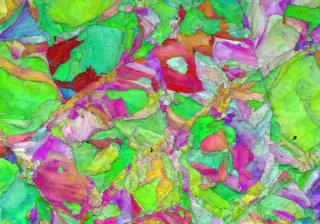Numerical simulations are a quite recent alternative to design materials and solve physical problems with a reduced impact on the environment. VTT aims for excellency in that aspect through a physics-based multi-scale material modeling workflow. Crystal plasticity is a slab in that chain that I had the chance to discover and contribute to its development during my summer job at VTT.
My role at VTT as a summer trainee
As a summer worker, I had some prejudice that I would be only my supervisor’s shadow and that my tasks would be rather simple and with a low impact on the project. Instead, I discovered the magnitude of the project I am part of and have been offered only challenges. VTT is one of the collaborators in an EU project seeking to improve the efficiency of Energy Intensive Industries while reducing Green House Gas emissions by using components of better quality and productivity. My tasks involve the parametrization of the microstructural CPFEM model developed by VTT for a novel High-Entropy Alloy (HEA) that has been additively manufactured (AM). But beforehand it was necessary to do an intense literature review on crystal plasticity so I could apply the knowledge learned at university properly to the CPFEM model.
At VTT, my opinion is relevant, listened and guided when needed. This shows trust in the trainee and encourages one to give the best of themself. All the other trainees I’ve had the pleasure to meet have shared the same feeling. I’ve had a chance to meet them both in person and online, although unfortunately, the ones I have met have been mostly from the second group. Nevertheless, I have nothing to complain about, as despite the coronavirus situation we are living in, working from home is efficient and the working environment is healthy.
Materials design and virtual testing
High-Entropy Alloys, or HEAs are like many safes, each one with its own password. Engineers are locksmiths who, every time they pick the right combination, gain access to next-generation materials. These novel materials have excellent properties and can replace the most advanced materials used for extreme conditions to date. Until such a winner combination is discovered, the investment in resources can be huge if it is done through the traditional simple but crude design methodology. Here is where physics-based multi-scale material modeling and machine learning steps in.

More specifically, CPFEM provides a better understanding of material’s performance and properties based on their manufacturing, resultant microstructure, and present failure and strengthening mechanisms. VTT offers a solution with the mentioned workflow, which includes additive manufacturing (AM) as a manufacturing method due to its design freedom and minimal raw material utilization.
Virtual testing reduces the number of physical tests needed, development and certification risks, prototyping costs, and time to market; it also improves and strengthens components design by exposing them to conditions difficult to replicate in physical experiments. VTT has shown me how good material’s design via virtual testing can make for building better and more sustainable world, which can only be achieved through teamwork and a constant desire for facing challenges.
The writer is a second-year master’s student of materials science and engineering at Polytechnic University of Madrid and University of Tampere. He is working on the ACHIEF materials design project at VTT during the summer of 2021.




